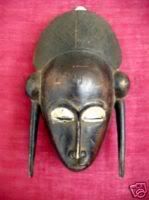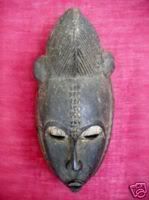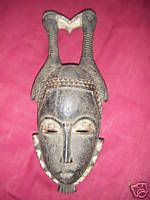More and more people such as art galleries, collectors and even tourists visiting Africa tend to sell African art. However all these people tend to only look at African art with an aesthetic judgement and they forgot that the objects were not created for this purpose. Their creators wanted to create sacred objects useful for their communities. So the question is how can you sell and inform about African art and craft without omitting the main goal of the African artists?
It is important to know that African art went through different status over the last centuries. Of course, all the different status were always set by the Westerner people:
-XVth-XVIIIth century: African art = curiosity
While the Portuguese are the first to arrive in Black Africa , they try to impose the christianity to African people and they burn any wood art created by the inhabitants for their rituals. However Portuguese have a growing interest for ivory and gold. So to sum up during this period, all the ritual and sacred objects are encountering a negative judgment from the Portuguese and the other objects ( objects made of ivory for instance) are judged using Westerner criteria and they are brought back to Europe to be shown in what is called “ curiosity” chambers. These special chambers were successful until the XVIIIth century. The main goals of these chambers are to entertain, fascinate and teach.
-XIXth century: From curiosity to scientific objects
At the end of the XIXth century, the westerner expeditions changed and scientists are now part of them. Slowly the “curiosity chambers” became museums. The objects placed in museums are now used for ethnographic specimen and they are the witnesses of civilization progress. During this period, the objects are only studies by ethnologists and never by art historians. In the last 25 years of the XIXth century, colonialism is fully part of the Westerner strategies and universal exhibitions show African objects and also humans. African people are brought back to Europe to be put in museums so that westerner people can see how it is to live in Africa.
-XXth century : From scientific objects to primitive arts
Primitive arts appeared since the middle of the XIXth century but at this period, the expression “ primitive arts” means that it was created by people in the first period of evolution. A lot of Westerner artists had an interest for African objects but they only look at them from an aesthetic point of view.
-Today : An art fully recognized but still not fully understood by a lot of persons
Since 1960, primitive art has a growing public. For instance the Branly museum opened in 2005.
You can discover African art by visiting the following website: http://www.myafrikart.com
Sunday, July 27, 2008
Thursday, July 10, 2008
The Baoulé tribe
As mentioned previously, the Baoulé tribe is part of the bigger ethnic group called the Akan. The Baoulé live mainly in the middle of Cote d’Ivoire. The Baoulé population is estimated to be around 3 millions.
The Baoulé originally come from Ghana and they were lead to Cote d’Ivoire by Queen Abla Pokou. I wrote an earlier note in relation to Queen Abla Pokou. Their name come from the legend in relation to the Queen Abla Pokou and “baouli” means “ the child is dead”.
One of the former president of Cote d’Ivoire named Houphouët-Boigny was part of the Baoulé tribe.
The Baoulé as a lot of ethnic tribes in Ivory Coast have their own dance:
-Goly dance
- Adjemele dance
-Adjos dance
- Kotou dance
The Baoulé are famous sculptors, weaver and goldsmith.
The Baoulé believe in a creator God. Their God controls men and animals. Spirits have supernatural powers. The real world is the opposite of the spiritual world where souls come from at birth and go back at death. Their belief is founded around the death and the immortality of the soul. The Baoule do ancestors workship but ancestors are not represented.
In the Baoule culture, sculptures and masks allows them to be in contact with the spiritual world. Baoule traditional masks are always wore by the men. Traditional masks corresponds to 3 types of dances/events
- Gba gba: originally from the Guro tribe, this mask is used for women funerals during the harvest seasons. It celebrates beauty.
- Bonu amuen: it protects the village from outside threats. It appears during the death of notable people.
- Goli: this mask has a rounded form and two horns. It celebrates peace and happiness.
In contrary to other ethnic groups, the sculptors skills are not passed over from father to son. It results from a personal choice.



You can see more masks if you visit : http://www.myafrikart.com
The Baoulé originally come from Ghana and they were lead to Cote d’Ivoire by Queen Abla Pokou. I wrote an earlier note in relation to Queen Abla Pokou. Their name come from the legend in relation to the Queen Abla Pokou and “baouli” means “ the child is dead”.
One of the former president of Cote d’Ivoire named Houphouët-Boigny was part of the Baoulé tribe.
The Baoulé as a lot of ethnic tribes in Ivory Coast have their own dance:
-Goly dance
- Adjemele dance
-Adjos dance
- Kotou dance
The Baoulé are famous sculptors, weaver and goldsmith.
The Baoulé believe in a creator God. Their God controls men and animals. Spirits have supernatural powers. The real world is the opposite of the spiritual world where souls come from at birth and go back at death. Their belief is founded around the death and the immortality of the soul. The Baoule do ancestors workship but ancestors are not represented.
In the Baoule culture, sculptures and masks allows them to be in contact with the spiritual world. Baoule traditional masks are always wore by the men. Traditional masks corresponds to 3 types of dances/events
- Gba gba: originally from the Guro tribe, this mask is used for women funerals during the harvest seasons. It celebrates beauty.
- Bonu amuen: it protects the village from outside threats. It appears during the death of notable people.
- Goli: this mask has a rounded form and two horns. It celebrates peace and happiness.
In contrary to other ethnic groups, the sculptors skills are not passed over from father to son. It results from a personal choice.



You can see more masks if you visit : http://www.myafrikart.com
Subscribe to:
Comments (Atom)
